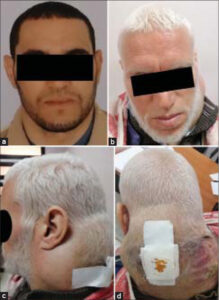Rare case of rapid hair depigmentation with Pazopanib
Ephraïm Lonté Kintossou , Ganiou Adjade, Kalil Cisse, Rhizlane Belbaraka
, Ganiou Adjade, Kalil Cisse, Rhizlane Belbaraka
Department of Medical Oncology, CHU Mohammed VI, University Cadi Ayyad, Marrakech, Morocco
Citation tools:
Copyright information
© Our Dermatology Online 2023. No commercial re-use. See rights and permissions. Published by Our Dermatology Online.
Sir,
Pazopanib is a multi-target tyrosine kinase inhibitor (TKI) that targets and inhibits vascular endothelial growth factor receptors, platelet-derived growth factor receptors, and stem cell factor (SCF) receptor c-kit. This results in inhibition of tumor angiogenesis and cell proliferation, thereby preventing tumor growth. The therapeutic efficacy of pazopanib in patients with metastatic renal cell carcinoma (mRCC) has been demonstrated in several clinical trials. Commonly reported adverse events were hypertension, diarrhea, hair color changes, anorexia and nausea [1].
Hair depigmentation has been reported with multi-target receptor TKIs such as sunitinib, pazopanib, and imatinib due to their c-kit inhibition [2–4]. Change in hair color was reported in 35% of patients treated with pazopanib according to drug safety studies. In a few reported cases, hypopigmentation was first noted after 1-5 cycles of treatment and gradually developed to reach its maximum after 6-10 cycles [5,6].
We report a case of canities in a 36-year old man (Fig. 1a) followed for a metastatic pleomorphic soft tissue sarcoma treated with pazopanib in 2nd line after progression under conventional chemotherapy. A cervical MRI performed showed a suspect intramuscular tumor process of the left paravertebral space. Resection of the mass was performed. At the anatomopathological and immunohistochemical study, it was an aspect of spindle-shaped and pleomorphic sarcoma dedifferentiated grade III with anti-EMA markers (+) PS100 (-) CD34 (-) CDK4 (-). The evolution after surgery was marked one (1) year later by a local and metastatic recurrence in the lungs. He was therefore put under first-line bi- chemotherapy with Adriamycin + Ifosfamide (AI) protocol. After three cycles, the patient was in clear clinical progression. He received then a tyrosine kinase inhibitor (TKI) type Pazopanib (Votrient®) 800mg per day. The assessment after three months under pazopanib showed clinical and radiological improvement at the cost of canities. Indeed, the patient reported progressive white coloring of his hair, eyebrows, mustaches, beard, and pubic hair after one month under Pazopanib (Figs. 1b – 1d).
 |
Figure 1:(a) Hair color before treatment (pazopanib) (b-d) Hair discoloration after one month of treatment with pazopanib and tumor appearance in beginning of second line. |
This clinical case will inform patients and remind healthcare professionals of this side effect associated with the administration of certain tyrosine kinase inhibitors and draw attention to the importance of document in order to improve our patient care in the management.
Consent
The examination of the patient was conducted according to the principles of the Declaration of Helsinki. The authors certify that they have obtained all appropriate patient consent forms, in which the patients gave their consent for images and other clinical information to be included in the journal. The patients understand that their names and initials will not be published and due effort will be made to conceal their identity, but that anonymity cannot be guarantee
REFERENCES
1. Sternberg CN, Davis ID, Mardiak J, Szczylik C, Lee E, Wagstaff J, et al. Pazopanib in locally advanced or metastatic renal cell carcinoma:results of a randomized phase III trial. J Clin Oncol. 2010;28:1061-8.
2. Hasan S, Dinh K, Lombardo F, Dawkins F, Kark J. Hypopigmentation in an African patient treated with imatinib mesylate:a case report. J Natl Med Assoc. 2003;95:722-4.
3. Sideras K, Menefee ME, Burton JK, Erlichman C, Bible KC, Ivy SP. Profound hair and skin hypopigmentation in an African American woman treated with the multi-targeted tyrosine kinase inhibitor pazopanib. J Clin Oncol. 2010;28:e312-3.
4. ŠeparovićR, PavlovićM, Silovski T, TečićVuger A. Rapid hair depigmentation in patient treated with pazopanib. BMJ Case Rep. 2018;2018:bcr2018224209.
5. 2010 ASCO Annual Meeting. Effect of pazopanib on hypopigmentation of hair and skin:a series of three patients. J Clin Oncol. 2010;28.
6. Meri-Abad M, Blasco Cordellat A, Camps Herrero C. Capillary and cutaneous hypopigmentation secondary to pazopanib. Med Clin (Barc). 2022;158:246-7.
Notes
Request permissions
If you wish to reuse any or all of this article please use the e-mail (brzezoo77@yahoo.com) to contact with publisher.
| Related Articles | Search Authors in |
|
|




Comments are closed.